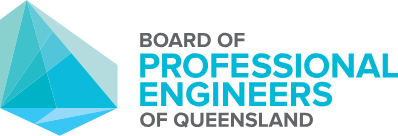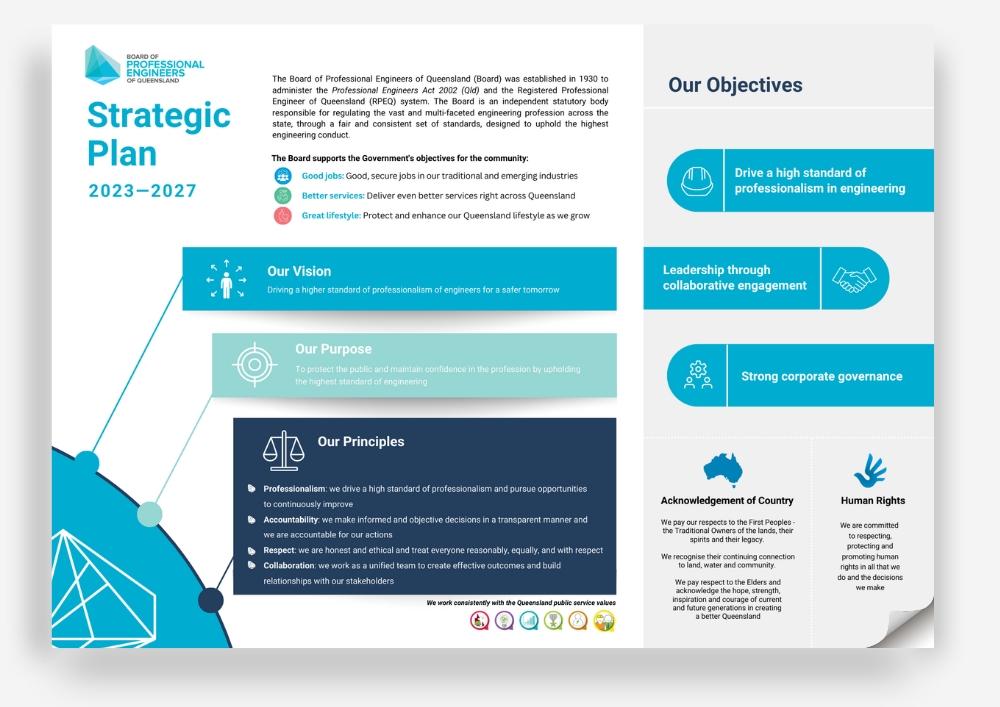
Strategic Plan
Our Vision
Driving a higher standard of professionalism of engineers for a safer tomorrow.
Our Purpose
To protect the public and maintain confidence in the profession by upholding the highest standard of engineering.
Our Principles

Professionalism
we drive a high standard of professionalism and pursue opportunities to continuously improve

Accountability
we make informed and objective decisions in a transparent manner and we are accountable for our actions



Respect
we are honest and ethical and treat everyone reasonably, equally, and with respect


Collaboration
we work as a unified team to create effective outcomes and build relationships with our stakeholders
Our Objectives
Drive a high standard of professionalism in engineering
Leadership through collaborative engagement
Strong corporate governance
For Queensland: Our role in Queensland’s future
We support the Queensland Government’s objectives for the community.
-
- Good jobs: Good, secure jobs in our traditional and emerging industries.
- Better services: Deliver even better services right across Queensland.
- Great lifestyle: Protect and enhance our Queensland lifestyle as we grow.
The Strategic Plan 2023–2027 recognises our commitment to human rights, acknowledges our First Peoples – all of which are central to the culture we want to achieve together.
The Strategic Plan 2023–2027 details the strategic risks that we need to manage, the opportunities we can pursue, the strategies we will employ to deliver our objectives and the performance indicators that will measure our success.
Strategic Opportunities


Amend and improve the legislation to better protect the profession and the public


Revise the areas of engineering to reflect changes in engineering and synergise areas of engineering of a similar nature


Attract and support more women into the profession


Continue to improve relationships with key stakeholders, peak bodies and industry to provide a more responsive and efficient public service



Create a new provisional category of registration for recently graduated engineers bridging the gap between graduation and registration as a professional engineer



Establish international networks to understand how other countries regulate engineers and coordinate regulatory efforts


Educate RPEQs to maintain high standards and professionalism through education


Lead the discussion regarding a National Professional Engineering Registration Scheme
Strategic Risks


Reputational Risk
The Board recognises that it must uphold its reputation through proactive engagement with its stakeholders.




People Safety Risk
The Board is committed to people safety, both internally and externally, in its role as an employer and regulator.







Protecting the Public
The Board is committed to protecting the public by ensuring professional engineering services are provided by a RPEQ in a professional and competent way.






Governance
The Board places great importance on governance and compliance and has a low appetite for any breaches in statute, regulation, professional standards, ethics, bribery or fraud.






WHS Risk
The Board aims to make its workplace a stimulating, supportive and safe place to work.







People and Culture
The Board continues to build high performance, dedicated, professional and innovative capabilities of its staff, through empowerment and leadership development.





IT & Cyber Security Risk/Threats
It is a requirement to ensure the Board’s systems and processes operate effectively and securely.





Compliance to the Professional Engineers Act 2002
The Board has little appetite for failure to comply with the Act that include persons, stakeholders or entities performing professional engineering services and assessments, subject to the materiality and/or potential consequences of the event.





 MY ACCOUNT
MY ACCOUNT



